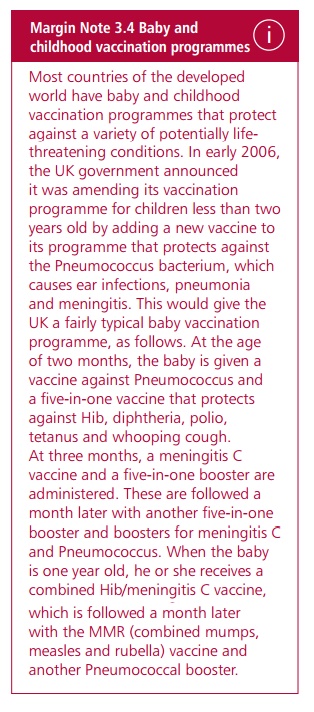Chapter: Biology of Disease: Infectious Diseases and Treatments
Preventing Infectious Diseases
PREVENTING INFECTIOUS DISEASES
Infections are the commonest cause of human morbidity
and mortality. In developing countries at the beginning of the last century
diseases, such as TB, pneumonia and bacterial infections secondary to
influenza, were major causes of death. However, in the developed world their
impact has been lessened by public health measures such as improved housing,
better sanitation and advanced social and economic conditions. Unfortunately,
in developing countries infectious diseases, such as malaria, TB, respiratory
and GIT infections, are still major causes of death, particularly in children.
The prevention of infectious disease is achieved by
the use of vaccines . Vaccination works by stimulating the immune system to
produce antibodies against the pathogenic organism by introducing bacteria or
viruses that have been rendered ‘harmless’ in some way. The simplest, though
not necessarily the most effective, method of preparing vaccines is by killing
whole microorganisms. These are then injected into the host to induce an immune
response. An example of a ‘killed’ vaccine is that used to protect against
whooping cough caused by Bordetella
pertussis. In some instances the immune response produced against dead
organisms is insufficient to induce good immunity. This is usually because
killing the microorganism often involves denaturing their proteins so while the
immune response recognizes the denatured proteins it does not react to the
native proteins on the pathogen. To overcome this problem, live but attenuated
(weakened) microorganisms may be used. These microorganisms are less virulent
and, in most cases, stimulate an effective immune response in the host. This
type of approach is used for the combined vaccine against measles, mumps and
rubella (MMR) and for the oral vaccine against poliomyelitis (Margin Note 3.4).

Some patients do not develop an effective immune
response to these weakened microorganisms and, unfortunately, the weakened
microorganisms can become virulent again, a phenomenon known as reversion. To overcome this problem,
selected proteins, from, for example, bacterial capsules or viral envelopes,
are extracted from the microorganism and used as vaccines. These are known as
subunit vaccines. Unfortunately, bacterial capsular polysaccharide is often
poor at stimulating immunity and a recent development is to render the vaccine
more immunogenic by attaching the polysaccharide to an immunogenic protein.
Such vaccines are known as conjugate
vaccines: examples include the most recent vaccines against Neisseria meningitidis serogroup C, and Haemophilus influenzae.
Subunit vaccines against viral proteins can now be
produced more cheaply by employing recombinant DNA techniques. In such cases,
nucleic acid coding for the protein in question is isolated and cloned. This
DNA is then transfected into a suitable microorganism which can be cultured and
induced to synthesize the protein in
vitro. An example is the recombinant vaccine against Hepatitis B produced
in the yeast Saccharomyces cerevisiae
that have been transfected with a gene encoding the S (surface) protein of the
virus. More recently, DNA vaccines, which consist of viral genes transfected
into bacterial plasmids and injected directly into muscle, have been undergoing
clinical trials, although, as yet, none of these is routinely available.
For those infectious diseases where toxins , rather
than the microorganism, are responsible for the disease, vaccines may be
prepared against chemically modified or heat inactivated toxins. These inactive
toxins, known as toxoids, are then
used for vaccination purposes and, indeed, this is the approach used for
diphtheria and tetanus vaccines.
Related Topics